Installing a washing machine: step-by-step installation instructions + professional advice
Modern life cannot be imagined without a washing machine.The priority is automatic models, which relieve as much as possible from hard work. A smart machine does everything on its own, but it is necessary to create conditions under which the unit will work for a long time and uninterruptedly.
One of the important points to ensure reliable operation is the installation of the washing machine and its subsequent connection. How to do this correctly and what nuances may arise during installation? We will analyze all the points in detail in this material. We will also consider the features of installing a washing machine in various conditions - in the kitchen, in the hallway, in the bathroom, etc.
The content of the article:
Recommendations from installation experts
It often happens that equipment installed independently or by a master begins to vibrate during the spin cycle. This indicates that the installation was performed incorrectly.Therefore, even before purchasing, you need to decide on a place for the machine and read the recommendations of installation specialists.
Professional advice on installing a washing machine, as well as step-by-step instructions will help you complete the installation and connection according to all the rules.
Tip #1 - prepare the conditions for installation
Choosing dimensions, the type of construction and technical characteristics of the model, are guided not by their own wishes, but by the capabilities of the room in which it will stand.
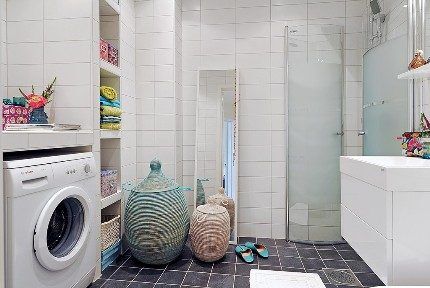
Necessary conditions for the operation of the washing machine include close proximity to an outlet and water. This will help avoid lengthening of electrical cables and hoses.
They also pay attention to ease of use, as well as the aesthetic component. Problems with placement most often arise in small apartments.
Tip #2 - choose the optimal room
Most users, when choosing a location, choose the bathroom as the most suitable from a logical point of view. After all, this is where the water pipes and sewer drains are located. In addition, the washing process will be hidden from view.
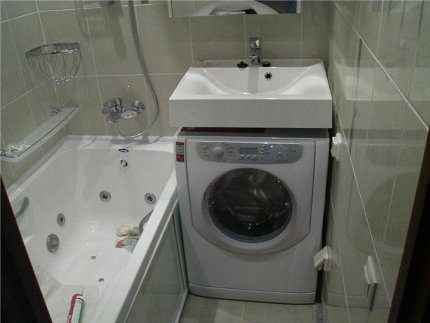
When choosing a location for the machine, pay attention to the following points:
- the ability of the floor to withstand vibrations;
- possibility of laying communications over remote distances;
- during measurements it is necessary to take into account unevenness on the walls;
- the space for installing the machine must be at least 1 cm larger than its nominal dimensions.
If space is limited and the dimensions of the machine are large, you should think about placing the unit in the kitchen or hallway.
Tip #3 - The Importance of Proper Connection
The issue of correctly connecting the washing machine to communications should be treated extremely carefully. Next we will consider this process in more detail.
Connecting water to the machine
Machine washing, like any other, is impossible without water. The water supply must meet two basic requirements: sufficient pressure in the pipes and clean water.
If they are not observed, establish pressure booster pump, and the water is filtered. A tap is built into the pipe supplying water to the machine to shut it off. Thus, the likelihood of leakage becomes minimal.
Electricity supply issue
A washing machine is a powerful unit. Residents of old apartments in which the wiring has not been changed are recommended to install a separate cable, since the wires and sockets installed many years ago are not suitable for connecting modern equipment. The cable cross-section must correspond to the expected load.
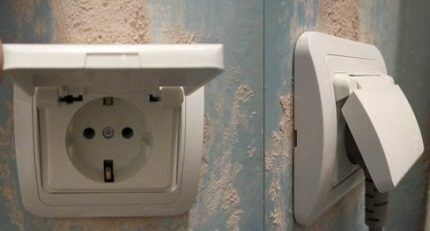
We discussed in detail the installation and connection of a grounded socket in this material.
Tip #4 - take into account external factors
The ambient temperature and type of flooring should also be taken into account when installing the washing machine.
High quality flooring and flooring
There are high demands on the quality of the floor.It must be strictly horizontal, hard and even.
The floor covering will have to withstand the vibrations created by the rotating drum. If there are doubts about the quality, it is necessary to strengthen it at the installation site of the machine.
Ambient temperature
In a heated apartment or house, equipment is kept warm. During prolonged heating outages, which are often observed in country houses and technical rooms, the equipment cannot be left in place.
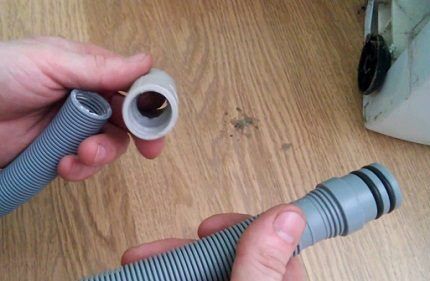
Stages of installation work
Once your new machine is delivered from the store, it is stripped of any packaging materials and shipping fasteners. Then the height of the legs is adjusted, and the machine is connected to communications. From this moment you can start the first wash.
Step #1 - Removing the Shipping Bolts
To prevent the moving parts of the washing machine from being damaged during transportation, they are secured with special fasteners (bolts, bars, brackets).
If they are not removed when turning on the machine, the owner of the equipment will be disappointed. It will inevitably fail. To prevent this from happening, the bolts are unscrewed, the plastic spacers are removed, and the brackets are removed.
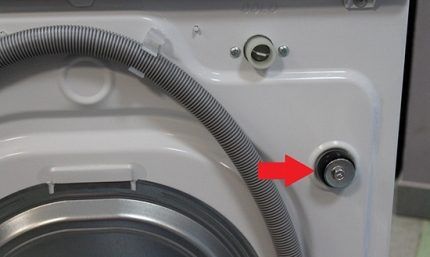
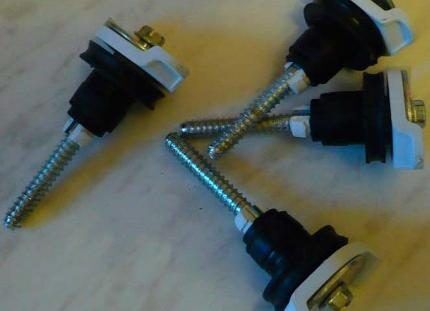
Special plugs supplied with the device are inserted into the holes for the bolts.
Step #2 - connecting to the water supply system
The machine is connected to the cold water supply using the included flexible hose. A hard connection is not recommended, since vibrations will affect the pipes, gradually destroying them.
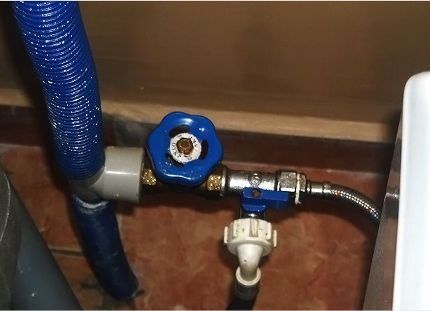
A filter is inserted into the water inlet, which is included with the unit. The nut connecting the hose to the machine is screwed in by hand. The rubber seal ensures tightness. The second end of the hose is also manually (without keys) connected to the cold water tap.
The hose is connected to the water supply through an embedded pipe or tee. As a rule, it has a filter to purify water from contaminants. It is connected to the machine using a conventional threaded connection.
Step #3 - arrangement of drainage of used water
The temporary and simplest solution for organizing water drainage is to place the end of the hose into the bathtub or sink. Typically, waste water is drained into a siphon located under the sink through a splitter.

The hose must be long enough to allow it to sag and form a loop. The water that will be in the fold will block access to the unpleasant odor coming from the sewer.
To properly connect to the sewer line, you need to connect the drain hose. This is done in one of the following ways: directly into the sewer or through a drain in a siphon under the sink.
To prevent water from draining by gravity and the spread of unpleasant odors, a water seal is created by bending the hose. Its upper level should be 60 cm above the floor plane. Detailed instructions for connecting the washing machine to the sewer and water supply are given in next article.
Step #4 - adjusting the legs according to the level
The rotation of the drum should be smooth, without distortions. This is achieved due to the strictly horizontal position of the upper plane.
The inspection is carried out using a building level. If the deviation is more than 2°, the legs will need to be adjusted. This is done by twisting them.
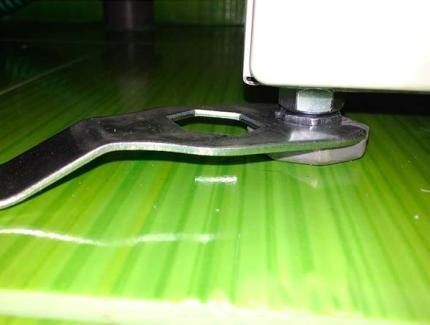
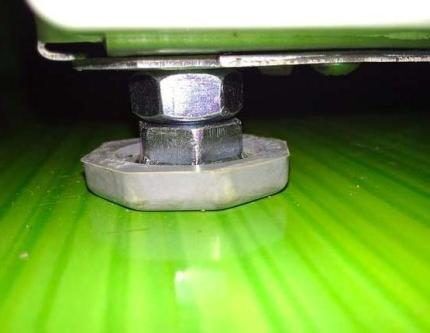
Strong vibrations can lead to breakdown of individual parts of the machine and disable the unit. You should not level the position of the machine by placing pieces of wood, linoleum or other spacers under the legs, as they can easily jump out during operation.
Step #5 - connecting to power supply
The optimal solution is to connect to the panel using a three-core cable on which a circuit breaker is mounted. Protection against short circuit to the frame is provided by the device RCD.
The outlet also has special requirements.It is mounted above the floor level at a height that will not allow water to enter in the event of a leak - not lower than 30 cm. In addition, it must be grounded.
We recommend that you familiarize yourself with the principles installing an outlet for a washing machine, which is supposed to be installed in the bathroom.
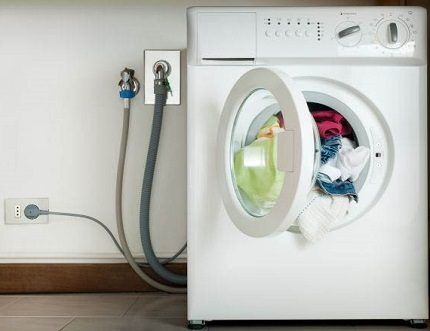
Step #6 - Verify installation is correct
If all the steps have been carried out step by step, taking into account professional recommendations, and the machine is connected to all communications and the plug is inserted into the socket, then it’s time to test its performance.
And at the same time make sure that all actions are performed correctly. To do this, water is supplied and the operation of the unit is checked. those. it starts - washing without laundry. If leaks are detected in the hose connections, the nuts are tightened.

Another important point to remember is preserving the packaging from the new washing machine. The fact is that it must be stored for 7 days in case of exchange if the machine turns out to be faulty, defective or damaged. The reason for the return may also be a discrepancy between the dimensions.
What to do if the car “jumps”?
Most often, increased vibration occurs after the installation of machines. But time-tested units can show their “character” by bouncing and moving across the floor.

To prevent equipment failure, it is necessary to establish the cause of the vibrations and eliminate it immediately.
Strong vibrations can be observed in the following cases:
- They forgot to remove the fasteners (brackets, bolts) that hold moving elements during transportation.
- Uneven floor causing the machine to wobble.
- The floor is slippery and too flat and should be covered with a rubber mat.
- The laundry inside the drum has curled up into a ball.
Excessive vibrations can also be caused by technical reasons, which can only be identified and eliminated by a specialist. Such reasons include damage to shock absorbers, wear of the springs that secure the tank, loosening of the counterweight fastenings, bearing failure and etc.
Any of the listed reasons must be urgently eliminated, since delay is fraught with breakdown. Self-confidence and previous experience are good reasons for installing household appliances yourself.
Professional advice on how to properly install a washing machine yourself, as well as clear instructions, will help you do it without errors.
Installation options for various conditions
Before installation, you need to think about the conditions and mode in which the machine will operate. Based on this, measures are taken to eliminate operational problems in the future.
Installing a machine in a private house
The layout of electrical cables and pipe routing must be thought out at the construction or renovation stage.
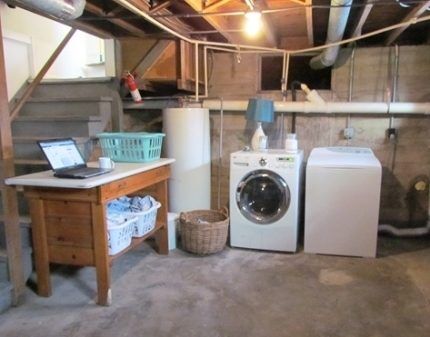
The dry basement of a private house is the best place to install washing and drying equipment. In this case, the residents of the house do not feel noise, odors and dampness.
Installation of appliances in the kitchen and hallway
Washing does not go well with cooking and eating food. However, very often the machine is installed in the kitchen, as its design fits perfectly into the interior.
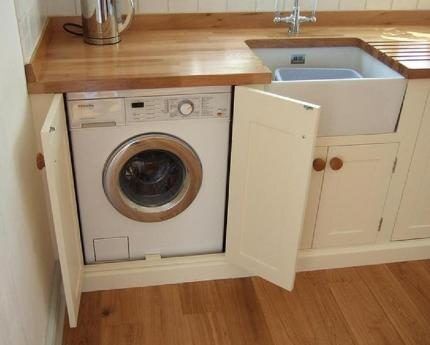
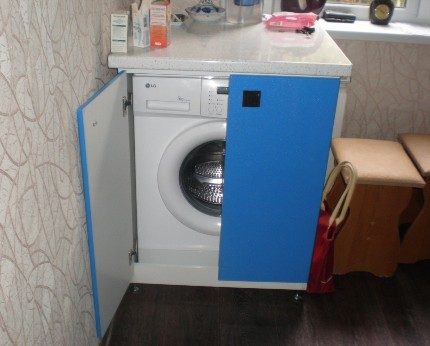
You can rarely see her in the corridor. It is difficult to find a place for such an installation and you will have to resolve issues regarding laying communications into the floor or walls. You will also need to hide the machine behind a curtain, place it in a built-in closet or under a countertop.
Placement on laminate or wood floors
The ideal surface for a washing machine is hard and rigid concrete. A wooden floor increases vibrations, which have a destructive effect on surrounding objects and the unit itself.
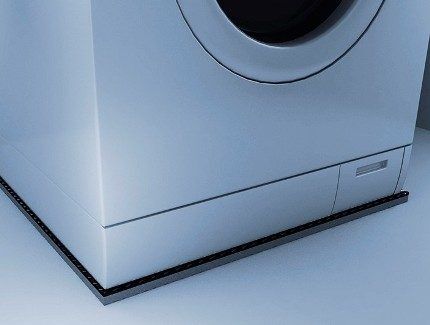
The floor can be strengthened in several ways:
- concreting a small foundation;
- arrangement of a durable podium on steel pipes;
- using an anti-vibration mat.
The listed methods will help reduce unpleasant vibrations, but they cannot be compared with concrete screed.
Features of installing a built-in machine
The built-in model is an ideal option that will fit into any interior. Hoses and wires are hidden behind the cabinet, and its front door is identical to the unit.
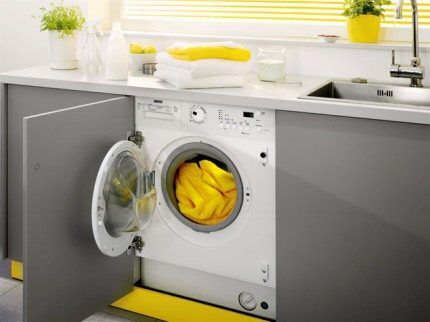
This type of equipment is more expensive than conventional equipment, so many are interested in whether and how it is possible to install or build the machine into a cabinet.
The problem to be solved is accomplished in several ways:
- by installing under the countertop;
- placing a compact model in a ready-made cabinet;
- installation in a specially made cabinet, with or without a door.
To prevent adjacent cabinets from experiencing vibration, the base must be solid.
Installing the machine above the toilet
For owners of small toilets, the idea of installing a machine above the toilet may seem strange. But there are enthusiasts who can solve even such a difficult problem.
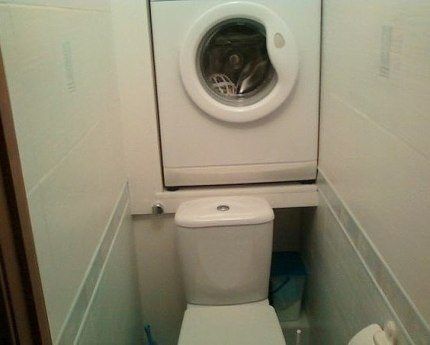
When planning installation, pay attention to the following points:
- If the quality of the walls is in doubt, a steel structure resting on the floor is made.
- The hanging shelf is made from a durable metal profile.
- The shelf is equipped with a safety side so that the machine does not slide off it due to vibration.
- The retractable shelf will prevent laundry removed from the machine from falling into the toilet.
- The mounting height is such that the toilet flush pit remains within the access area.
- It is more convenient to place the machine not above the toilet, but behind it.
- It is more advisable to choose a model with shallow depth.
In order for the unit to remain suspended and not fall on its head at the most inopportune moment, it is necessary to adhere to safety precautions.
Please remember that if necessary repair, the heavy machine will have to be lowered to the floor and then returned to its place.
Conclusions and useful video on the topic
Useful tips for those who decide to install the machine themselves:
How to connect water and sewer with your own hands:
How to “curb” a galloping car:
Step-by-step installation of a washing machine:
The installation process of the washing machine is quite simple and does not take much time. Its quality depends on many factors. An inexperienced equipment owner should not take on the job, as the consequences can cause a lot of trouble for him and his neighbors. In this case, it is better to contact a specialist.
Would you like to supplement the above material with useful installation or connection recommendations? Or noticed inaccuracies or inconsistencies in information? Please write about this in the comments to our publication.
If you have questions or can’t figure out a certain step of the washing machine installation instructions, ask our experts and other site visitors for advice.




The installation tips are clear, but they are not useful or feasible in all situations. For example, placing a washing machine in the hallway, in my opinion, is not at all aesthetically pleasing. Although, of course, the situation with free space is different.I personally, when connecting the washing machine, faced the problem of uneven floors. I had to struggle to get the machine level. And without this, at high speeds she jumped like crazy.
I just have a washing machine in the hallway, in a niche behind the wall of the bathroom. True, it was necessary to lay the inlet and drain in the floor, but there were repairs and this did not cause serious problems. Modern cars have a fairly aesthetic appearance, so I think it’s useless to hide them somewhere. But I consider combining washing and cooking a disgusting option.
When I was renovating the bathroom, I immediately chose the place where the washing machine would be located, since I connected the outlet to the sewer, a water supply branch and an outlet to it. During installation, you need to place it at a distance from the walls so that when pushing it out it does not hit the wall. Don't forget to check the shipping bolts, because I forgot to remove them and it started hitting the floor so hard. And on uneven floors, you can use the adjustable legs.
By the way, when I bought my first automatic washing machine, I also forgot to unscrew the shipping bolts. However, she didn’t jump much for me. Essentially, the bolts simply hold the drum, causing it to only rotate, but not move back and forth. My washing machine only jumped when it was not leveled. A couple of measurements and twisted legs quickly change the situation.
Hello Maxim! I agree with you that it is necessary to check the transport bolts, because when spinning, the washing machine will hit the floor if you do not remove it. Even my neighbors complained, but then I removed it and everything was fine.I was lucky that it didn’t make noise on its own, so I took the hotpoint.
We connected three Indesites (with a difference of just a couple of years) and I can definitely say that this is done manually very simply.
There are also rubber “anti-vibration” feet on sale (set of 4 pieces) that actually reduce noise from the SM.
The article is useful, the tips for installing a washing machine are explained clearly. It would seem a simple situation, but we personally encountered the fact that after purchasing a washing machine, we forgot to remove the shipping bolts, which is why at first the machine behaved restlessly during washing.